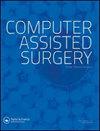微创手术技术治疗中老年远外侧椎间盘突出症。
IF 1.9
4区 医学
Q3 SURGERY
引用次数: 0
摘要
目的探讨不同微创技术治疗中老年椎间盘远外侧突出症的临床效果。经皮内镜下腰椎间盘切除术、MIS-TLIF联合对侧椎板间螺钉和MIS-TLIF联合双侧椎弓根螺钉通过回顾性图表复习进行评估。本文分析了74例中老年远外侧椎间盘突出症患者的资料。所有患者均接受手术治疗;19例为PELD, 24例为MIS-TLIF CTS, 31例为MIS-TLIF BPS。临床资料包括切口长度、手术时间、出血量、住院时间、手术费用、复发率、融合率。评估并记录术前和术后患者预后,包括VAS评分、ODI评分和MacNab标准。平均随访时间26.4个月(14 ~ 46个月)。与内固定组比较,PELD组切口长度、手术时间、出血量、住院时间均明显低于内固定组。三种方法的手术费用差异有统计学意义。与术前相比,术后腰痛和腰痛VAS评分明显下降。术后ODI评分低于术前。根据MacNab标准,分别有27例、37例和10例患者获得优秀、良好和公平的结果。PELD、MIS-TLIF CTS和MIS-TLIF BPS都是治疗中老年单节段远外侧腰椎间盘突出症的有效微创技术。PELD手术时间短,手术创伤小,创伤小,经济实惠;然而,固定后没有复发的椎间盘突出。与MIS-TLIF BPS相比,MIS-TLIF CTS获得了相似的融合率,并节省了一定的成本。本文章由计算机程序翻译,如有差异,请以英文原文为准。
Minimally invasive surgical techniques for the therapy of far lateral disc herniation in middle-aged and elderly patients.
To examine the clinical results of different minimally invasive techniques for the therapy of far lateral disc herniation in middle-aged and elderly patients. Percutaneous endoscopic lumbar discectomy, MIS-TLIF combined with contralateral translaminar screw and MIS-TLIF combined with bilateral pedicle screws were evaluated via a retrospective chart review. Data from 74 consecutive middle-aged and elderly patients with far lateral disc herniation were analyzed. All patients underwent surgery; 19 with PELD, 24 with MIS-TLIF CTS, and 31 with MIS-TLIF BPS. Clinical data included the length of the incision, duration of the operation, blood loss, hospitalization time, operation cost, recurrence rate, and fusion rate. Preoperative and postoperative patient outcomes including the VAS, ODI scores and MacNab criteria were assessed and recorded. The mean follow-up time was 26.4 months (range from 14 to 46 months). Compared with the internal fixation groups, the length of the incision, duration of operation, blood loss, and hospitalization time were obviously lower in the PELD group. The difference in operation cost among the three methods was statistically significant. The postoperative VAS scores for LBP and LP decreased significantly as compared with those recorded preoperatively. The postoperative ODI scores were lower than those recorded preoperatively. MacNab criteria rating excellent, good and fair results were in 27, 37 and 10 patients, respectively. PELD, MIS-TLIF CTS, and MIS-TLIF BPS are all effective minimally invasive techniques for the therapy of single segment far lateral lumbar disc herniation in middle-aged and elderly patients. PELD had a shorter operation time and less surgical trauma, being a less invasive and more economical method; however, there was no recurrence of disc herniation after fixation. Compared with MIS-TLIF BPS, MIS-TLIF CTS obtained a similar fusion rate and certain costs were saved.
求助全文
通过发布文献求助,成功后即可免费获取论文全文。
去求助
来源期刊

Computer Assisted Surgery
Medicine-Surgery
CiteScore
2.30
自引率
0.00%
发文量
13
审稿时长
10 weeks
期刊介绍:
omputer Assisted Surgery aims to improve patient care by advancing the utilization of computers during treatment; to evaluate the benefits and risks associated with the integration of advanced digital technologies into surgical practice; to disseminate clinical and basic research relevant to stereotactic surgery, minimal access surgery, endoscopy, and surgical robotics; to encourage interdisciplinary collaboration between engineers and physicians in developing new concepts and applications; to educate clinicians about the principles and techniques of computer assisted surgery and therapeutics; and to serve the international scientific community as a medium for the transfer of new information relating to theory, research, and practice in biomedical imaging and the surgical specialties.
The scope of Computer Assisted Surgery encompasses all fields within surgery, as well as biomedical imaging and instrumentation, and digital technology employed as an adjunct to imaging in diagnosis, therapeutics, and surgery. Topics featured include frameless as well as conventional stereotactic procedures, surgery guided by intraoperative ultrasound or magnetic resonance imaging, image guided focused irradiation, robotic surgery, and any therapeutic interventions performed with the use of digital imaging technology.
 求助内容:
求助内容: 应助结果提醒方式:
应助结果提醒方式:


